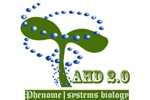Status:
Platform:
Species:
Plant hormones are small organic molecules that influence almost every aspect of plant growth and development. Genetic and molecular studies have revealed a large number of genes that are involved in responses to numerous plant hormones, including auxin, gibberellin, cytokinin, abscisic acid, ethylene, jasmonic acid, salicylic acid, and brassinosteroid. Here, we develop an Arabidopsis hormone database, which aims to provide a systematic and comprehensive view of genes participating in plant hormonal regulation, as well as morphological phenotypes controlled by plant hormones. Based on data from mutant studies, transgenic analysis and gene ontology (GO) annotation, we have identified a total of 1026 genes in the Arabidopsis genome that participate in plant hormone functions. Meanwhile, a phenotype ontology is developed to precisely describe myriad hormone-regulated morphological processes with standardized vocabularies. A web interface (http://ahd.cbi.pku.edu.cn) would allow users to quickly get access to information about these hormone-related genes, including sequences, functional category, mutant information, phenotypic description, microarray data and linked publications. Several applications of this database in studying plant hormonal regulation and hormone cross-talk will be presented and discussed.[1]
Phytohormone studies enlightened our knowledge of plant responses to various changes. To provide a systematic and comprehensive view of genes participating in plant hormonal regulation, an online accessible database Arabidopsis Hormone Database (AHD) has been developed, which is a collection of hormone related genes of the model organism Arabidopsis thaliana (AHRGs). Recently we updated our database from AHD to a new version AHD2.0 by adding several pronounced features: (i) updating our collection of AHRGs based on most recent publications as well as constructing elaborate schematic diagrams of each hormone biosynthesis and signaling pathways; (ii) adding orthologs of sequenced plants listed in OrthoMCL-DB to each AHRG in the updated database; (iii) providing predicted miRNA splicing site(s) for each AHRG; (iv) integrating genes that genetically interact with each AHRG according to literatures mining; (v) providing links to a powerful online analysis platform WebLab for the convenience of in-time bioinformatics analysis and (vi) providing links to widely used protein databases and integrating more expression profiling information that would facilitate users for a more systematic and integrative analysis related to phytohormone research.[2]
References
- Arabidopsis Hormone Database: a comprehensive genetic and phenotypic information database for plant hormone research in Arabidopsis.,
, Nucleic Acids Res, 2009 Jan, Volume 37, Issue Database issue, p.D975-82, (2009)
- AHD2.0: an update version of Arabidopsis Hormone Database for plant systematic studies.,
, Nucleic Acids Res, 2011 Jan, Volume 39, Issue Database issue, p.D1123-9, (2011)







